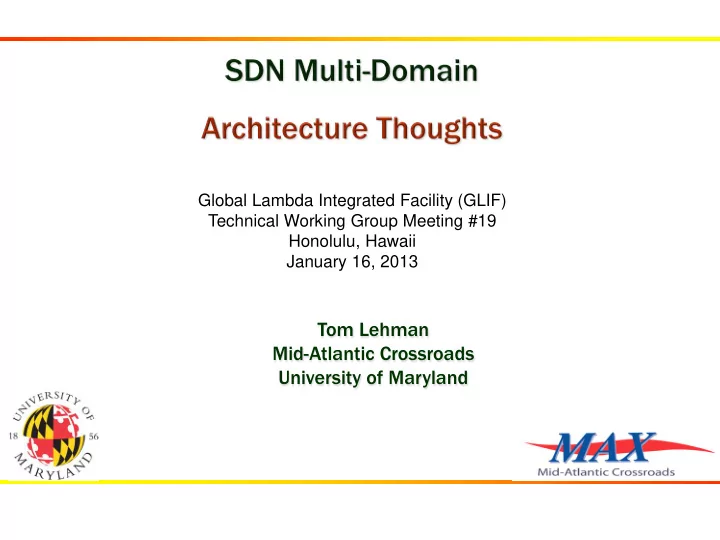

Global Lambda Integrated Facility (GLIF) Technical Working Group Meeting #19 Honolulu, Hawaii January 16, 2013 Tom Lehman Mid-Atlantic Crossroads University of Maryland
Perspective/Reference Points/Assumptions • SDN is an abstract, undefined term which basically just means that we can do things dynamically in the network via an API • OpenFlow is one type of API and/or control mechanism which can be part of an SDN domain • There will be other APIs and control mechanisms which will be part of SDN • We can design a Multi-Domain SDN solution by considering similar things to what we need to consider for any Multi-Domain Service systems • Administrative domain demarcations will remain at base level - recursion and slicing will be used to present users with something different
Perspective/Reference Points/Assumptions • From a user perspective we will be provisioning "services", which need to be defined. • OpenFlow Service Example: user uses and API to get a FlowTable rule inserted in their favorite OpenFlow Network which gives them some vlan and mac space, and then they fire up their own OpenFlow Controller to create slices • MultiPoint Topololgy Service Example: user gets a multi-point topology over which they run their own applications. internal mechanism may be via OpenFlow, or may be via other mechanisms
Key Architectural Considerations • SDN Multi-Domain Service may be more accurate term then SDN Inter-Domain • OpenFlow is both a control plane and a data plane • The data plane is unique as compared to other data planes we have dealt with: • flowspaces can cover alot of areas and unique combinations • At the OpenFlow control plane level, we also have options: • let users run their own openflow controller and talk to network flowvisor • just provide user services thru an API, with OpenFlow being the internal mechanism to get things done
Key Architectural Items • User Services Definition • Controller Service API • Tree vs Chain messaging • Real-Time resource identification (multi-round negotiation protocols) • schemas (syntax, semantics, use cases) for service and resource descriptions • Topology Service • These are the most • Export/Distribution (realtime vs static) important things that need to be done first • schemas (syntax, semantics, use cases) for • This is the language for resource descriptions describing services and • Computation Service resources • Resource/Path Computation • Common set of schemas for topology descriptions and service request/responses • Authentication/Authorization Features • needed for Service Requests and Topology Viewing
Key Architectural Items • There are multiple architectures and many protocols which can make this work • All of the protocols and schemas in discussion today could be used as part of this Architecture solution/implementation • But the architecture/system is more then just a protocol • many details must be specified and implemented associated with all the architecture components • not sure who will design/implement/test/support the full system? • it would be helpful if there was more coordination/development synergy across the various projects working on these issues
One Architectural Approach (based on experience with OSCARS, DRAGON, GENI) • Centralized at the Intra-Domain level for resource management and service provisioning • Distributed at the Multi-Domain level for resource management and service provisioning • External topology distribution systems must not require large/frequent dynamic data export (scalability and stability issues) • Resource identification for real-time service provision can only be done by local domain systems • Multi-domain service provision based on tree mode protocols which include real-time negotiation/multi- phase commit features
Multi-Domain SDN Architecture
GENI Network Stitching Architecture
OSCARS/IDCP
Recommend
More recommend